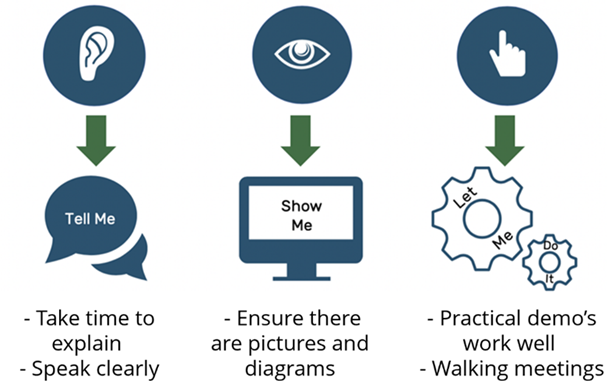Tailoring communication to enhance understanding
How to use representational systems to improve communication
Consultant, Stephanie McKay, outlines the main representational systems and explains how tailoring your communication can enhance understanding.
Have there been times when communicating with others where you’ve thought to yourself:
- ‘they just aren’t hearing me’
- ‘how are they not seeing this’; or
- ‘I’m just not feeling it’?
This can be quite frustrating and leave you wondering ‘what am I doing wrong here’ or even ‘what’s their problem!’. Well, I can’t guarantee this will be the answer, but it’s certainly something that has helped me understand why this can happen.
According to Richard Bandler and John Grinder, the co-founders of neuro-linguistic programming (NLP), we preference the way we receive and communicate information through our representation systems. What are they you ask?
Representational systems are the way we make sense of the world, they are the channels by which information initially enters our experience. The three main representational systems we will discuss are Visual, Auditory; and Kinesthetic (VAK).
While all systems are available to us at any given time, quite often a preference for one over the other is established. In some cases, individuals can become so reliant on a particular representation system that they may completely miss out on information if it’s not delivered in their preferred way.
Why is this important to know?
By learning someone’s representation system preference you can tailor your approach to communicate more effectively with them. Firstly though, it’s worth being able to recognise what someone’s preference is. So what are some of the ways you might tell what a person’s VAK preference is?
Visual preference:

In general, people who have a visual preference:
- Memorise or retain information better by seeing pictures.
- Are more distracted by physical movement rather than auditory noises.
- Have trouble remembering or become bored by long verbal instructions.
- Are more interested in how something looks and value appearances.
- Often stand or sit with their hands / bodies erect and eyes upward.
- Notice changes to their environment.
- Tend to learn by being shown how to do something or by reading how to do something.
They will often use phrases such as:
- ‘I see what you are saying’
- ‘Seeing eye to eye’
- ‘Mental picture’
- ‘Take a peek’
Auditory preference:

In general, people who have an auditory preference:
- Find noise distracting.
- Pay attention to sounds, tones, and volumes.
- Learn best by listening and can easily repeat information verbally.
- Like music and talking on the phone.
- Values tone / volume of voice.
- Talk to themselves.
- When learning, like to be told how to do something.
They will often use phrases such as:
- ‘I hear you’
- ‘I’m all ears’
- ‘Tongue tied’
- ‘Describe in detail’
Kinesthetic preference:

In general, people who have a kinesthetic preference:
- Memorise by doing something.
- Are more interested that something ‘feels right’ or evokes the right feelings.
- Make gestures close to their body, (eg. hand over heart).
- Talk slowly and in a breathy way.
- Use their body to think, remember and communicate.
- Learn by doing something.
They will often use phrases such as:
- ‘Get a handle on’
- ‘Catch on’
- ‘I have a gut feeling’
- ‘Connect with’
Applying this knowledge
Now you have some further understanding of the behaviors and language of each VAK preference, let’s apply it. Give the following step-by-step process a go, to develop your skills.


Tailoring your communication at work
This information can be extremely valuable in the workplace where understanding your colleagues preferred representation system can enable you to work more cohesively, give clearer instructions and generally save a lot of time and energy. Here are just a couple of tips on how to tailor your communication for each VAK preference at work:


But what if you don’t know what someone’s representational system preference is? A good rule of thumb is to cover all your bases. If you’re presenting to new people, try to incorporate tips from across all representational systems:
- Talk clearly
- Have a presentation; and
- Offer demonstrations where possible
Then pay attention – listen to the words they use, watch for their behaviours and get curious about what they are paying attention to, then adapt your presentation (or future interactions) to suit.
To wrap up
So next time you notice others not ‘seeing what you are saying’, ‘hearing you’ or ‘catching on’, take a few minutes to determine their VAK preference and try the communication again. With some practice, this skill can lead to better interactions, and relationships not just at work, but with those closest to you.
Did you enjoy this article? Catch up on more 2PM insights here.

